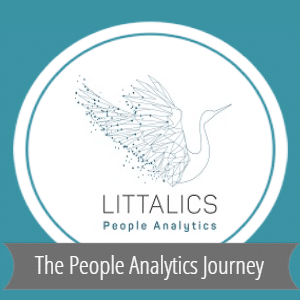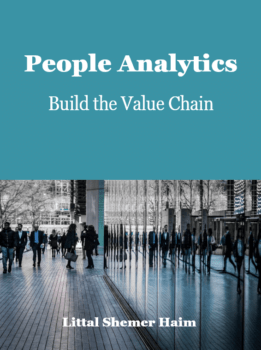Imagine the highest degree for sophisticated data usage. If there was such a degree, which organizations would be nominated to hold it? Undoubtedly, the Israeli intelligence corps would be at the top of the list. Could you imagine People Analytics practices in such an organization? Personally, I would love to have a sneak peek into the People Analytics function of this organization. Wouldn’t you?
I was excited to talk with Limor Pinto, a Lieutenant Colonel in the Israeli Military intelligence, who will retire in a few weeks. In her last role, she served as a Head of the Behavioral Sciences Branch in the Intelligence Corps Headquarters. I met her for the first time four years ago, when I talked to the IDF Behavioral Sciences department about People Analytics, and later again in another learning opportunity of the Intelligence Corps. Fast forwarding the years, Limor was generously shared with me some of her experiences. Here’s a rare chance to explore the most secure organization in our country and probably the entire world. How do People Analytics practices look from an insider perspective? It’s a lucky day! Let’s find out.
Untypical career steps
LSH: You are an expert in Organizational Behavior Studies, but you ended up as a Workforce AI Leader. It is not a typical career leap forward. How did your service enable it?
LP: One of the critical challenges that the Israeli intelligence corps face is identifying patterns in individuals’ behaviors and predicting their intentions. We must excel in doing so, in preventing events such as terrorist attacks. We leverage AI to predict enemy plans. However, we have similar predictive needs when we handle our workforce. Just as we can spot on a suicide bomber using AI, we can alert out talent intentions to carry a particular behavior, e.g., leave the organization. As a strategic advisor to the high command, I have recommended leveraging our intelligence experience in workforce challenges and adopting AI to predict workforce behaviors.
LSH: Experts in Behavioral Science can impact organizations in many ways. Why did you decide to focus on People Analytics?
LP: Indeed, behavioral scientists are engaged in research methodologies, like surveys and focus groups, to understand groups and individuals in organizations. However, such methods lack the predictive ability, namely, to associate attitudes and motives to actual behaviors. We tend to interpret research findings based on our experience, but we may be wrong in our judgments and professional gut feelings. People Analytics, and particularly predictive analytics, can cover us.
Innovation in HR
LSH: Can you give an example of a wrong judgment that the predictive analytics project contradicted?
LP: Consider, for example, a typical attitude of commanders towards young women officers. They interpreted attrition related to these women’s work-life balance challenges, who handle both career and young families. However, women who did not participate in career succession interviews at the right time, were entirely practical in managing their careers and initiating their next step elsewhere since no one in the army discussed it. Their commanders referred it to these women challenges to cope with the intense routines of Intelligence units. Interestingly, such a pattern was not characterizing male officers.
LSH: The Intelligence units’ reputation in technology and analytics is well known. But what is it like to lead innovation in Human Resources, which may be considered less glamorous?
LP: My team partnered with tech units and experts. However, innovative leadership was owned by our behavioral sciences practitioners. Some tech experts thought they should own the project and challenged our leadership. But eventually, we established an advisory board that represented all parties, and we were extremely sensitive, so we managed to make everybody feel that they are the owners. This board had an essential part in funding the project. We also had an additional committee of users, comprised of volunteers who contributed to data munging, hackathons, implementation, and even ethics discussions.
Challenges and wins
LSH: We’ll certainly get back to ethics later, but first, let’s discuss other challenges. It sounds like a part of your challenge in leading workforce AI wasn’t technical, but rather political.
LP: It was complicated. It’s not easy to do the fundraising internally, but when you succeed in that, the expectations for quick wins are high, while the implementation takes like forever. We experienced the tension between the tech experts and HR practitioners, who were actually on their reskilling journey. The AI experts considered the joint venture as their own and insisted on managing the conversation with programmers and data scientists. The HR practitioners thought it’s an organizational project or intervention to help individuals and commanders. We end-up in assigning a senior officer who basically handled the conflicts daily and prevented the parties from political dead-ends.
LSH: Tell me more about your approach to finding and prioritizing business questions.
LP: Priorities were determined in command discussions, after extracting business questions from a comprehensive organizational diagnosis. We focused on questions related to talent retention, high command promotion, and workforce reaction to upcoming changes in geographic locations of units and compensation.
Actionable workforce insights
LSH: What data sources you had and how did you leverage the integration of data from different sources?
LP: We retrieved structured data about people’s backgrounds and activities from their long journey in the military serves, e.g., psychometrics, demographics, sociometric, and unstructured data from evaluation processes and interviews. We also purchased relevant data about the Israeli labor market and received data from other Israeli army units, concerning commute times, attitudes among tech talents, and more. When we integrated the data from those different sources, we succeeded in offering insights, and particularly, alternative explanations.
LSH: How did you transform your findings into actionable insights?
LP: We gained a new understanding of daily phenomena and realized that some of our former responses were completely irrelevant. For instance, in the case study of women officer attrition that I mentioned earlier, commanders were required to discuss career paths with their officers right after signing their first contract with the army. We also re-generated academic programs and compensation plans modularly to offer more tailor-made career solutions. Our impact was significant, and eventually, we won the Commander-in-Chief Award for creative thinking.
Ethics questions
LSH: Let’s go back to the Ethics questions. What kinds of issues were raised, and how did you handle them?
LP: Yes, we had plenty of ethical issues, e.g., notifying individuals about using their data, limiting our sources of data in the appropriate way for the workforce, as opposed to the enemy, limiting permissions to access the data, and more. The senior board handled most of the discussions and decisions. However, we consulted layers, content specialists in the Intelligence Community, and academic researchers in AI ethics.
LSH: In a glance into the future, how this project will mark your career path?
LP: undoubtedly, this project was essentially a start-up within an organization, or should I say, the most institutionalized organization in the State of Israel. It was an opportunity to explore and express myself as an entrepreneur and innovation leader. But most of all, we managed to solve complex problems in the intelligence corps, which we tried to solve for years by our HR strategy. The breakthrough emerged when we transformed HR strategy into an HR data strategy. Predicting workforce behaviors become even more crucial nowadays in Covid19 times. I’m confident that this career-shaping experience will provide value to civil organizations in the public and private sectors in my next career journey as a citizen.
LSH: Thank you, Limor, for sharing your fascinating experience.
I look forward to following your journey as a citizen expert in People Analytics, and to continue collaborating in educating the next generation of People Analytics leaders in Israel and globally!







